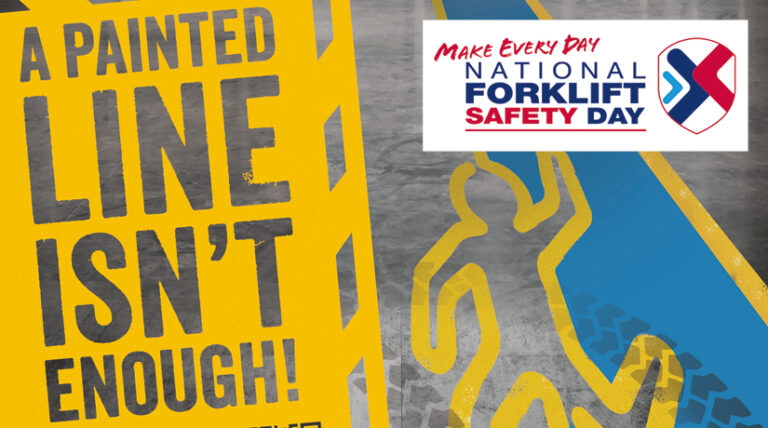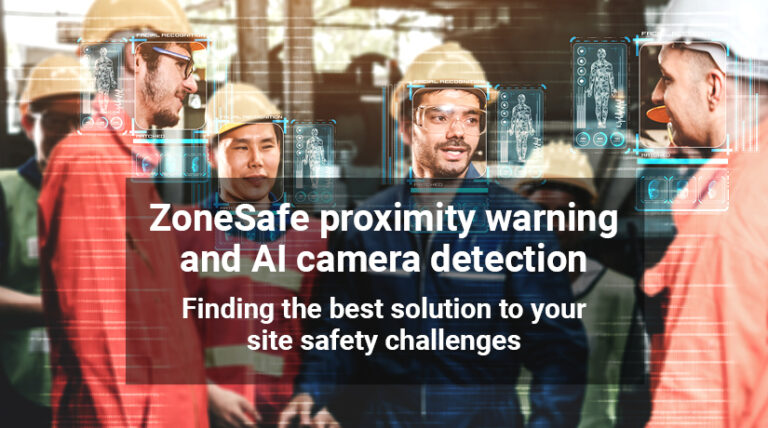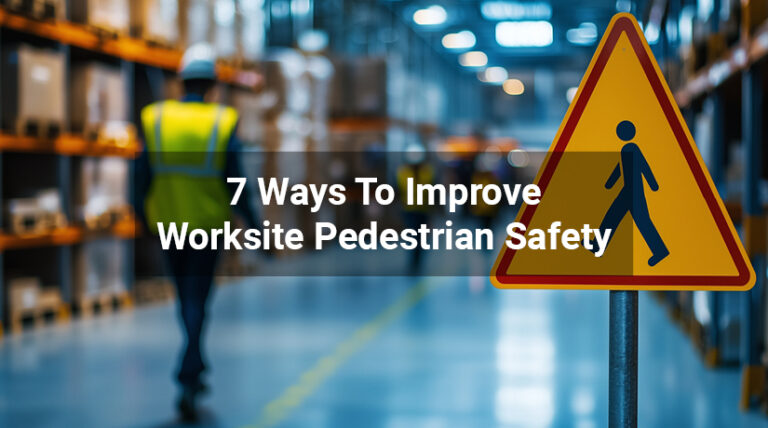A Comprehensive guide to the segregation of vehicles and pedestrians
To enable segregation, and the safe movement of vehicles and pedestrians, the layout of pedestrian routes and traffic routes in the workplace is extremely important.
These are rules for detailing segregation in any workplace. Designating the layout of these routes is mainly for permanent business locations, yet sometimes may be applicable to temporary and mobile workplace and vehicles, such as logistics companies and construction sites.
Risk assessment for segregating vehicles and pedestrians
The first step is to have a risk assessment for all traffic routes. This is so that if there is an incident, it can be shown that steps have been taken to prepare for every situation, and to show every safety aspect of your site. These are some things to take into consideration when carrying out your risk assessment:
For vehicles:
- For access and entry to the site – does any vehicle traffic have to cross major roads to enter or exit your site? Could they use any alternative route?
- Control vehicles and pedestrians entering and exiting the site, perhaps by use of barriers or access gates. Gates and entrance barriers that have to be operated by drivers should be done from a safe location. If gates/barriers are to stay open they should be sufficiently secured.
- Drivers should have the required visibility enabling them to see hazards, and it should be ensured that the landscape does not visibility, especially at junctions. In certain places, it may be sensible to have boundary fencing (such as wire mesh) instead of walls so as not to restrict vision.
- Reversing should be eliminated wherever possible. One way systems should be encouraged where possible, as well as turning points if space is limited.
- Traffic routes should be constructed of suitable material for the required location, the type of traffic and the size of the route. The route should have adequate drainage, a firm, suitable driving surface, and should be wide enough for the movement of the largest vehicle and its load.
- Routes should avoid entrances or doorways that are used by pedestrians. They should avoid blind bends, sharp bends and steep slopes. If they cannot be avoided, mirrors should be provided to improve vision.
- Overhead electrical cables or pipelines which may be an issue. Look at areas where height clearance or height restriction may be a problem.
When pedestrians are involved:
- It is imperative that pedestrians should be segregated from vehicles. Separate footpaths or walkways should be provided for pedestrians. These walkways should be wider when larger groups of people are expected to use them.
- Pedestrians should have crossing points that are clearly visible for both the driver AND the pedestrian. If the pedestrian traffic is heavier at times, there should be other considerations in place, such as traffic lights, subways or bridges. Designated crossing points should be directed to using barriers or railings.
- Barriers should be placed at entrances and exits to prevent pedestrians to walk into the path of traffic. Vehicles and pedestrians should have separate entrances into buildings.
- Busy periods (lunch time and start and finish of the working day) should have considerations for prohibiting or limiting vehicle traffic in areas that pedestrians may be using.
- Pedestrians should wear high-viz jackets or vests in areas that vehicles are also working.
Road markings and signage:
- It is important to signpost all internal and external pedestrian traffic routes. This should also include restricted and no parking zones, pedestrian crossings, traffic lanes, directions, junctions, stop lines, changes in gradient, speed limits and sharp bends.
- Road markings AND all signage should comply with the Department of Transport Traffic Signs Manual and the Safety, Health and Welfare at Work Regulations, 2007. All signs should be clearly understood by all who use them. Pictures and images should be used when possible. When used outside of daylight hours, reflective and illuminated signage should be used.
- Place signage in locations that give enough time to see clearly and understand the signs for them to take appropriate action. These could be: traffic routes, speed limits, pedestrian walkways etc. When signs are in larger areas and places of business, for example factories, docks and ports, maps should be placed at prominent locations.
Traffic control/speed:
- Appropriate speed limits should be put in place on site. Be aware that separate areas of the site may require different speed limits. Take into account road layout, size of site, the size of vehicles using the route and differing loads being carried.
- The speed limits should be monitored and enforced once the limit is in place. There should be markers and/or CCTV cameras monitoring the speed of vehicles between two fixed points.
- Limit vehicle speed using traffic calming ideas, for example; rumble strips, speed humps, raised curbs or traffic-slowing narrow section on parts of the routes.
- Audio and visual alerts are very effective for warning both drivers and pedestrians. Traffic lights, speed sensors, flashing warning signs and audio alerts are popular. ZoneSafe’s system uses both and is extremely effective. See below for details.
Safe systems of work.
A site assessment should take place, and a traffic management plan should follow. This part of the plan will form an important section of the overall traffic management. It is important that visiting drivers are aware of the site rules and traffic management. They should know who to report to and where, with the layout of the workplace and the traffic route that they should take.
HSE guidelines – and the law.
The Health and Safety Executive (HSE) states that by law, pedestrians or vehicles must be able to use a traffic route without causing danger to the health or safety of people working near it.
Roadways and footpaths should be separate when possible, and by law, traffic routes must also keep vehicle routes far enough away from doors or gates that pedestrian use – or from pedestrian routes that lead on to them – so that the safety of the pedestrian is not threatened.
Risk assessment questions
When undertaking a risk assessment, these questions should be answered:
- How are pedestrians kept away from vehicles?
- How have you marked out vehicle and pedestrian areas?
- Where do vehicles and pedestrians have to use the same route?
- How have you marked out and assigned crossing points:
- For drivers?
- For pedestrians?
- How do you tell drivers and pedestrian about the routes and the layout? For example:
- Staff who work on site
- New staff
- Visitors
- Apart from collisions, what else presents a health and safety risk? For example:
- Materials falling from vehicles
- Noise
- Fumes
If you are just performing a risk assessment for segregation, here is a simple guide, issued from the HSE:
Segregation guide
Provide separate vehicles and pedestrians doors wherever possible (segregation). Windows on doors can help drivers and pedestrians to see whether it is safe for them to approach a door.
If vehicles use routes inside buildings, use signs and markings on the floor to tell warn operators of vehicles and pedestrians.
Provide enough clearance between the vehicles and pedestrians, and take care to make sure that fixtures along the route do not create trapping hazards.
What happens when you cannot segregate?
Sometimes, there are scenarios in workplaces in which vehicles and pedestrians just cannot be segregated. This may be when there is such a great amount of vehicle and pedestrian traffic crossing one another at different times, that there cannot be strict segregation.
So how can you adhere to the HSE guidelines?
Invest in another safety precaution. Alarms are quite popular – audible sounds to warn both drivers of vehicles and pedestrians when they are in close proximity to each other.
When noise pollution is a distraction
There are times when noises in the workplaces are too loud to hear any warning alarms. This is combatted by using light sensors/warnings. But there may be obstructions so that line of sight is broken.
What can be used to show you have thought of all possibilities?
ZoneSafe uses technology to create detection zones around vehicles, assets, crossing points and walkways.
Active tags can be worn by personnel, fitted to assets or set up around hazards. Tags are identified by the ZoneSafe system when they enter the detection zone. This triggers an audible visual alert, warning vehicle operators of the tag’s close proximity to the vehicle.
ZoneSafe tags do NOT REQUIRE LINE OF SIGHT and will be detected REGARDLESS OF OBSTRUCTIONS, blind spots or poor visibility.
For more information on ZoneSafe’s suite of products, visit www.zonesafe.com.





